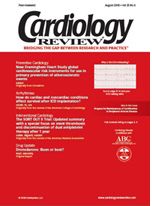Best vasoreactivity definition helps determine pulmonary hypertension outcome
Pulmonary Hypertension
Orlando—While vasodilator testing is an important diagnostic tool in patients with pulmonary hypertension, with reactive pulmonary vasculature being associated with improved prognosis, the numerous definitions of positive vasodilator response used in practice limit its utility.
The ideal definition of vasodilator response should provide the widest discrepancy in clinical outcomes between responders and nonresponders, said Richard A. Krasuski, MD, Duke University Medical Center, Durham, North Carolina, during the American College of Cardiology Annual Scientific Session 2005.
Dr. Krasuski and colleagues evaluated mortality differences between responders and nonresponders using various combinations of vasodilator response definitions.
A total of 93 pulmonary hypertension patients referred for pulmonary vasodilator testing were followed for a median of 39.5 months. Mean patient age was 45 years, and 80% of the patients were women. Primary pulmonary hypertension was present in 56% of patients, and 17% had systemic pulmonary hypertension. At baseline, patients had a mean New York Heart Association functional class of 2.9, mean right atrial pressure of 11 mm Hg, pulmonary artery (PA) systolic pressure
of 73 mm Hg, and arterial oxygen saturation of 90%. Long-term medication use included epoprostenol in 34% of patients, treprostinol in 7%, bosentan in 17%, calcium channel blockers in 37%, and warfarin in 57%.
Vasodilator testing was conducted with inhaled nitric oxide at 40 ppm; overall, 18% of patients responded to the challenge. Among responders, 94% survived through the follow-up period compared with 58% of nonresponders; 35% of the patients died. The greatest difference in mortality was seen when a positive response to nitric oxide testing was defined as more than a 30% decrease in mean PA pressure with a greater than 30% decrease in pulmonary vascular resistance (PVR). Patients meeting the 30% decrease in both measures had a mortality rate of
6% compared with the 42% rate among nonresponders.
PA pressure response alone, PVR response alone, and various combinations of percent response to each were assessed but were not as predictive of
survival as the 30% decrease in both measures. Mortality was 10% among responders and 42% among nonresponders for a 30% decrease in PA pressure alone; 20% and 48%, respectively, for a 20% decrease in either PA pressure
or PVR alone; and 29% and 45% for a
20% decrease in PVR alone. Mortality
was 28% among responders and 43%
among nonresponders for either a 30% decrease in PA pressure alone or a 30% decrease in PVR alone; 29% and 50% for a 20% decrease in PA pressure alone; 29% and 39% for a 20% decrease in both PA pressure and PVR; and 30% and 40% for a 30% decrease in PVR alone.
“The 30/30 definition of vasoreactivity appears to be an excellent tool in predicting long-term outcome in patients with pulmonary hypertension,” Dr. Krasuski said. Patients who experience a 30% decrease in both PA pressure and PVR have approximately one seventh the mortality of patients who do not. He concluded that this definition of vasoreactivity would be useful when initially evaluating patients, especially younger female patients presenting with dyspnea who are more likely to have pulmonary hypertension. “We just aren’t recognizing it early enough,” he said.
